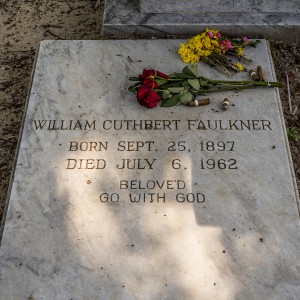William Faulkner’s
Mississippi Home
About Rowan Oak
In the 1940s at his home, Rowan Oak, Faulkner told ghost stories to the children in his family, including his niece and ward Dean Faulkner Wells, who has recounted three of them in The Ghosts of Rowan Oak: the haunting and heartbreaking story of Judith, the chilling tale of the Werewolf, and the macabre story of the Hound. Today, it apparently is William Faulkner who is doing the haunting. Rowan Oak is reportedly haunted by Faulkner’s spirit. He has been seen writing on the wall in his office and wandering the grounds. Rowan Oak, also known as William Faulkner House, is William Faulkner’s former home in Oxford, MS. It is a primitive Greek Revival house built in the 1840s by Robert Sheegog. Faulkner purchased the house when it was in disrepair in the 1930s and did many of the renovations himself. Other renovations were done in the 1950s. The house sits on four acres of landscaped land and twenty nine acres of largely wooded property known as Bailey’s Woods. One of its more famous features is the outline of Faulkner’s Pulitzer Prize–winning novel A Fable, penciled in graphite and red on the plaster wall of his study. Though the “rowan oak” is a mythical tree, the grounds and surrounding woods of Rowan Oak contain hundreds of species of native Mississippi plants, most of which date back to antebellum times. The alley of cedars that lines the driveway was common in the 19th century. The studs of the house are 4″x4″ square cypress, which were hand-hewn. Faulkner drew much inspiration for his treatment of multi-layered Time from Rowan Oak, where past and future seemed to inhabit the present.
In 1972, his daughter, Jill Faulkner Summers, sold the house to the University of Mississippi. The University maintains the home in order to promote Faulkner’s literary heritage. Tours are available. The home has been visited by such writers as John Updike, Czesław Miłosz, Charles Simic, Richard Ford, James Lee Burke, Bei Dao, Charles Wright, Charles Frazier, Alice Walker, the Coen brothers, Bobbie Ann Mason, Salman Rushdie, and others. Writer Mark Richard once repaired a faulty doorknob on the French door to Faulkner’s study.
After its most recent renovations, some of which were funded by part-time Oxford resident and Ole Miss law school alumnus, John Grisham, Rowan Oak was rededicated on May 1, 2005.
The current curator of Rowan Oak is William Griffith. Past curators include the novelists Howard Bahr and Cynthia Shearer. The original curator was Bev Smith, an Ole Miss alum, who was responsible for finding many of Faulkner’s original manuscripts hidden within the home. The address for the house was once 719 Garfield Road in Oxford, but the road changed names in the 1980s to Old Taylor Road.
Faulkner was fascinated with the history of the house and did significant amounts of restoration and repair work himself.
There are many apocryphal stories regarding Faulkner’s dislike of the University students (the University of Mississippi is nearby) who would use the woods surrounding the house as a spot to meet away from the eyes of authority figures. Supposedly this dislike was channeled into the infamous “corncob rape” in “Sanctuary”. Faulkner is buried in Oxford Memorial Cemetery. Faulkner is supposedly still active on his old homestead. He has been seen writing on the walls in his office. During renovation work, a plot outline for a novel was discovered written on the wall in black graphite and red grease pencil. This outline had been whitewashed over, presumably by Faulkner himself. In addition, there are tales of his spirit wandering the grounds, still on the prowl to scare away any students using his woods for night-time activities. The grounds are extensive with a trail that leads from the house to the parking lot of the university museum. Visitors are free to wander the grounds during daylight hours. Visitors to Oxford should also take the opportunity to visit Faulkner’s grave. Tradition calls for visitors to leave an offering of whiskey for the resident ghost of Mr. Faulkner.

Photo by:
New Orleans Art Photographer, William Sexton.
